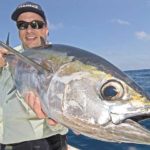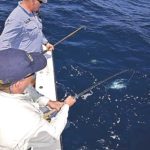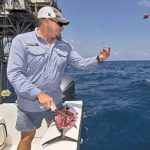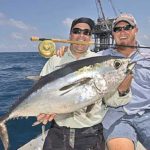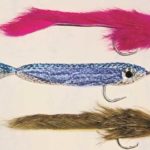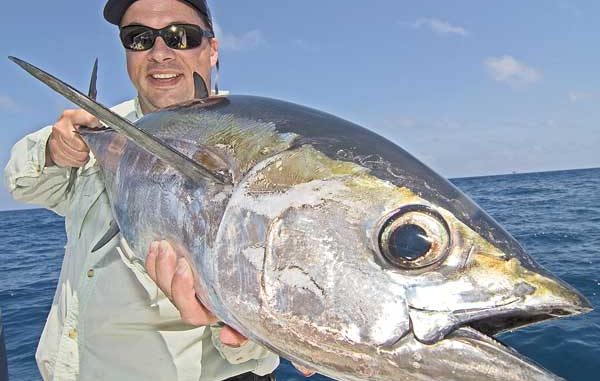
What do tuna and rabbits have in common? Head offshore this month with a fly rod, and you’ll find out quite quickly.
If fishing is like religion, then fly fishing is high church,” news anchor Tom Brokaw has said. And that’s pretty much the attitude of most fly fishermen: It’s the epitome of angling, the true essence of fishing unspoiled by so crude an implement as a casting reel.
Of course, if you ask many of these elitist anglers how many fish they caught after a trip, you’re as likely to get a mystified look as to see a stringer of soon-to-be fillets.
You see, fly fishing is all about the perfect technique. Just check out “A River Runs Through It,” and you’ll see that much is made over the beauty and skill of Brad Pitt’s character. Sure he could catch fish, too, but that was really a secondary concern. The real story was the artistry of his back cast, the distance he could send a fly and the accuracy of placement.
Watching the fictional Paul Maclean casting was just a thing of beauty.
So when Jeff Pierce secured three fly rods on the charterboat Pale Horse, images of dodging a fly all day as Pierce worked to get it in just the right place danced through my head.
The stated goal was catching a world-record fly-caught dolphin, and I figured I’d never get a chance to play with these athletic fish.
However, the situation degenerated even further when the rip couldn’t be found.
So, in the manner of any good skipper, Capt. Kevin Beach simply announced a change of plans.
“Let’s catch some tuna,” he said.
I figured that would be the end of the fly fishing, and it was for a time. Pierce, sales manager for Mustad Hooks, and I helped get things set up to drag live bait around a floating rig.
The first fish was an old bonito, which was quickly thrown in the bait tank for later use.
Soon it became apparent that live-baiting wasn’t going to produce big tuna, so Beach pulled out the bonito and began cutting chunks off as the boat drifted.
A 30-pound yellowfin and a couple of medium-sized blackfins soon hit the deck.
And then, out of the corner of my eye, I saw Pierce unsheathing a long fly rod. As I watched, he began tying on a pretty green rabbit-fur fly.
I couldn’t help myself.
“You can’t catch a tuna with a rabbit,” I pointed out.
Pierce never missed a beat.
“Have you ever seen any rabbits out here?” he asked, as he checked the connection of his Ti-Bunny. “That’s because (the tuna) ate them all.”
Beach just chuckled, sawed off another chunk of bonito and tossed it into the sapphire-blue waters surrounding the floating rig Mars. The finder was marking pods of fish about 150 feet down, and the red marks were beginning to turn upwards by the time Pierce walked to the gunwale with his rigged-out fly rod.
A shark soon appeared, calmly snagging food from the buffet Beach threw overboard. And then the first torpedo streaked through the chum, soon to be joined by numerous others as the school of tuna finally made it to the surface.
“Did you see that?” Pierce shouted.
I prepared myself to duck and dodge, maybe hit the deck of the boat, in hopes of keeping away from the fly hook as the excited angler made a dozen back casts before finally allowing the little puff of fur to settle in the water.
But there was no form to Pierce’s cast. Well, in fact, you couldn’t really call it a cast.
Instead, Pierce stripped out a wad of line, which fell at his feet, and then he simply tossed the green rabbit fur-covered hook into the water. He did snap his rod tip up and down a couple of times to push several feet of heavy fly line through the guides.
But no back cast. No whipping of the long rod between 10 o’clock and 1 o’clock while slowly feeding out line to get the fly a proper distance from the boat.
Nope, Pierce just grabbed the fly and threw it overboard to plop unceremoniously into the water about 4 feet from the hull.
Then, feeding line through the rod eyes, he let it drift slowly down next to a piece of chum.
Streaks of tuna flashed mere feet off the boat as we watched the fly descend. It didn’t take long: Pierce’s offering was there one second and gone the next, and the slack in the fly line was jerked taut.
With a yelp, Pierce yanked the line and set the hook, quickly letting go to prevent serious line burn. His reel screamed as the muscle-bound tuna on the terminal end realized its mistake.
The fight was surprisingly short, with Beach sticking a gaff in the thrashing blackfin in only about five minutes.
Far from exhausted, Pierce merely checked the fly and prepared for the next “cast.”
The morning wore on in much the same manner, with Beach luring tuna to the surface with chunks of bonito and small blackfin, and Pierce throwing out his fly only to see it quickly gobbled up in the feeding frenzy.
Strategy was pretty straightforward on this day. Beach would circle a rig with an eye on his fish finder until he located schools of fish. He’d then set up for the drift.
“You have to figure out whether the current or the wind is more dominant,” he explained. “Once you know which is going to affect your boat more, simply move upcurrent or upwind of the school of fish and shut the motor down.”
That last part is very important.
“A lot of people spook fish because they don’t shut their engines down,” Beach said. “The fish will still come up, but they’ll be a lot farther away from the boat.
“With fly fishing, it’s all about getting the fish as close as possible.”
That’s because, even if actually casting a lure, the angler is limited to how far he can push his fly.
Beach also learns in advance whether his anglers are left- or right-handed so he can set up the boat accordingly.
“I’ll remove the outrigger on the side that the angler will be casting from so it doesn’t get in the way,” he said.
Beach said drifting is just a matter of working the boat into position so the wind or current will push it over the school, with a mind toward providing an open casting area.
“You want to do everything you can to put the angler in the best position to catch the fish,” he said.
By the end of the day, more than a dozen tuna had fallen for Pierce’s fly. While all the fly-caught tuna were blackfins, several were huge.
“These are brute blackfins,” Beach said as he heaved in yet another 30-pounder.
And that’s the excitement of offshore fly fishing — there are tons of alternatives.
“We were going out for dolphin, and it just didn’t happen,” Pierce said. “There are so many things to do out here that you can fall back on something else.”
The incredibly diverse opportunities off Louisiana’s coastline also make it possible for anglers to have the trip of a lifetime.
“There are a lot of fishermen who have never hooked a yellowfin on a fly,” Pierce said. “Out here, the chances of doing that are very good. The guy who can make the longest cast will usually catch more fish, but even the beginner can catch fish out here.”
It wasn’t until days later, however, that Pierce discovered just how special this trip was.
“Three of those blackfin would have broken the current IGFA 20-pound (fly-fishing) world record,” he lamented. “The record is 30 pounds, 9 ounces, and we had two heavier than that.
“One was 33 pounds.”
